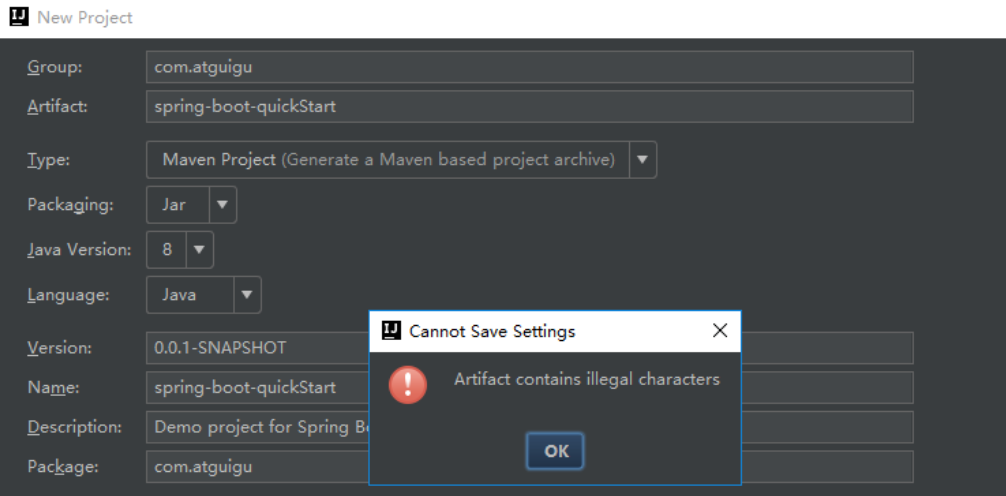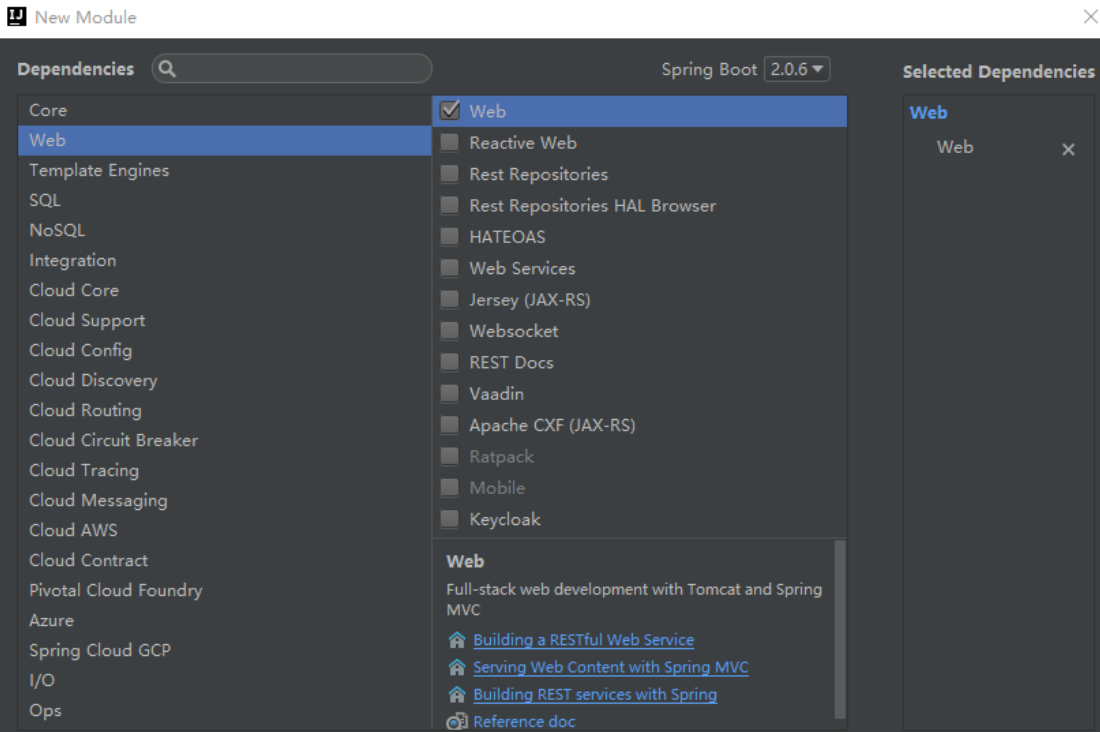SpringBoot——入门及原理
SpringBoot 用来简化 Spring应用开发,约定大于配置,去繁从简,是由 Pivotal团队提供的全新框架。其设计目的是用来简化新 Spring应用的初始搭建以及开发过程。该框架使用了特定的方式来进行配置(有特殊需求可以添加自己的配置覆盖默认配置),从而使开发人员不再需要定义样板化的配置。SpringBoot 可以看成是 J2EE的一站式解决方案。
一、SpringBoot 的优点
【1】快速创建独立运行的 Spring项目以及与主流框架集成。
【2】使用嵌入式的 Servlet容器,应用无需打成 war包,可以打成 jar包,通过 java -jar的方式直接运行。
【3】starters(启动器)自动依赖与版本控制。
【4】大量的自动配置,简化开发,也可以修改默认值。
【5】无需配置XML,无代码生成,开箱即用。
【6】准生产环境的运行时应用监控。
【7】与云计算的天然集成。
二、解决微服务部署和运维难的问题:Spring Boot

搭建项目 构建连接 批处理
三、Spring Boot 入门项目
HelloWorld(也可以参考五,快速创建一个 SpringBoot项目)
【1】准备环境:为 Maven 的 settings.xml 配置文件的 profiles 标签添加如下信息:
1 <profile>
2 <id>jdk-1.8</id>
3 <activation>
4 <activeByDefault>true</activeByDefault>
5 <jdk>1.8</jdk>
6 </activation>
7 <properties>
8 <maven.compiler.source>1.8</maven.compiler.source>
9 <maven.compiler.target>1.8</maven.compiler.target>
10 <maven.compiler.compilerVersion>1.8</maven.compiler.compilerVersion>
11 </properties>
12 </profile>
【2】将 IDEA 的 Maven更换为我们自己本地安装的 Maven。(自行百度更换)创建一个 maven工程(jar),在 pom.xml中导入如下依赖:
1 <parent>
2 <groupId>org.springframework.boot</groupId>
3 <artifactId>spring-boot-starter-parent</artifactId>
4 <version>2.0.0.RELEASE</version>
5 </parent>
6 <dependencies>
7 <dependency>
8 <groupId>org.springframework.boot</groupId>
9 <artifactId>spring-boot-starter-web</artifactId>
10 </dependency>
11 </dependencies>
【3】编写一个主程序,启动 SpringBoot应用
1 @SpringBootApplication
2 public class Hello {
3 public static void main(String[] args) throws Exception {
4 //启动spring应用
5 SpringApplication.run(Hello.class, args);
6 }
7 }
【4】编写相关的 Controller、Service类
1 @Controller
2 public class HelloController {
3 @ResponseBody
4 @RequestMapping("/hello")
5 public String hello(){
6 return "hello world!";
7 }
8 }
【5】运行主测试程序。简化部署应用<可以将应用打包成一个可执行的 jar包>:通过 Maven Projects中 的 package(双击)即可。生成 jar的位置:默认在项目的 target目录下的“项目名称.jar”文件。运行jar:在命令行可以通过 “java -jar jar文件名.jar” 命令运行项目。
1 <build>
2 <plugins>
3 <plugin>
4 <groupId>org.springframework.boot</groupId>
5 <artifactId>spring-boot-maven-plugin</artifactId>
6 </plugin>
7 </plugins>
8 </build>
四、Hello World 探究(POM文件)
【1】父项目(spring-boot-starter-parent):
1 <parent>
2 <groupId>org.springframework.boot</groupId>
3 <artifactId>spring-boot-starter-parent</artifactId>
4 <version>2.0.0.RELEASE</version>
5 </parent>
【2】进入 spring-boot-starter-parent发现它还有一个父项目 :
1 <parent>
2 <groupId>org.springframework.boot</groupId>
3 <artifactId>spring-boot-dependencies</artifactId>
4 <version>2.0.0.RELEASE</version>
5 <relativePath>../../spring-boot-dependencies</relativePath>
6 </parent>
【3】进入 spring-boot-dependencies后,发现如下信息,与之前我们创建的分布式项目继承的 Maven父项目功能是一样的,用来管理所有 jar包依赖的版本。称为 SpringBoot的版本仲裁中心,以后我们导入依赖默认是不需要写版本;(没有在dependencies 里面管理的依赖,需要声明版本号)
1 <properties>
2 <activemq.version>5.15.3</activemq.version>
3 <antlr2.version>2.7.7</antlr2.version>
4 <appengine-sdk.version>1.9.62</appengine-sdk.version>
5 <artemis.version>2.4.0</artemis.version>
6 <aspectj.version>1.8.13</aspectj.version>
7 <assertj.version>3.9.1</assertj.version>
8 <... 此处省略 .../>
9 </properties>
【4】启动器(spring-boot-starter-web)
1 <dependency>
2 <groupId>org.springframework.boot</groupId>
3 <artifactId>spring-boot-starter-web</artifactId>
4 </dependency>
spring-boot-starter-web:spring-boot-starter 指 spring-boot 场景启动器;进入官网可以到有许多场景启动器,简单点说就是通过此功能将相关 jar包给组合在起来,我们使用时只需要引入一个 Web Starter就可以轻松搞定。Spring Boot 将所有的功能场景都抽取出来,做成一个个的 starters(启动器),只需要在项目里面引入这些 starter相关场景,所有依赖都会导入进来。要用什么功能就导入什么场景启动器。

点击 web右边的 pom可以看到 SpringBoot为我们依赖的其它 jar包,帮我们导入了web模块正常运行所依赖的所有组件。如下:
1 <dependencies>
2 <dependency>
3 <groupId>org.springframework.boot</groupId>
4 <artifactId>spring-boot-starter</artifactId>
5 </dependency>
6 <dependency>
7 <groupId>org.springframework.boot</groupId>
8 <artifactId>spring-boot-starter-tomcat</artifactId>
9 </dependency>
10 <dependency>
11 <groupId>org.hibernate</groupId>
12 <artifactId>hibernate-validator</artifactId>
13 </dependency>
14 <dependency>
15 <groupId>com.fasterxml.jackson.core</groupId>
16 <artifactId>jackson-databind</artifactId>
17 </dependency>
18 <dependency>
19 <groupId>org.springframework</groupId>
20 <artifactId>spring-web</artifactId>
21 </dependency>
22 <dependency>
23 <groupId>org.springframework</groupId>
24 <artifactId>spring-webmvc</artifactId>
25 </dependency>
26 </dependencies>
【5】主程序类(Java类):@SpringBootApplication:此注解声明的类,是 SpringBoot的主配置类,SpringBoot就应该运行这个类的 main方法来启动 SpringBoot。
1 //@ImportResource(locations={"classpath:bean.xml"})
2 //@SpringBootApplication 来标注一个主程序类,说明这是一个SpringBoot应用
3 @SpringBootApplication
4 public class HellowordQuickStartApplication {
5
6 public static void main(String[] args) {
7 /*SpringBoot应用启动项
8 HellowordQuickStartApplication.class 参数必须是用@SpringBootApplication注解修饰的类
9 */
10 SpringApplication.run(HellowordQuickStartApplication.class, args);
11 }
12 }
@SpringBootApplication(主要由:@SpringBootConfiguration/@EnableAutoConfiguration/@ComponentScan 组成)
1 @Target(ElementType.TYPE)
2 @Retention(RetentionPolicy.RUNTIME)
3 @Documented
4 @Inherited
5 @SpringBootConfiguration
6 @EnableAutoConfiguration
7 @ComponentScan(excludeFilters = {
8 @Filter(type = FilterType.CUSTOM, classes = TypeExcludeFilter.class),
9 @Filter(type = FilterType.CUSTOM, classes = AutoConfigurationExcludeFilter.class) })
10 public @interface SpringBootApplication {
@SpringBootConfiguration:标注在某个类上,表示此类是一个SpringBoot的配置类。由以下注解组合形成:配置类 == 配置文件,配置类也是容器的一个组件,底层由 @Component等等组成。
1 @Target({ElementType.TYPE})
2 @Retention(RetentionPolicy.RUNTIME)
3 @Documented
4 @Configuration //表示此类是一个配置类 是spring的一个组件
5 public @interface SpringBootConfiguration {
@EnableAutoConfiguration:开启自动配置功能。也是一个组合注解,由以下注解组成(部分重要注解):
1 @AutoConfigurationPackage
2 @Import(AutoConfigurationImportSelector.class)
3 public @interface EnableAutoConfiguration {
@AutoConfigurationPackage:自动依赖相关的配置包,也是一个组合注解,主要由 @import 等注解组合
1 @Import({Registrar.class})//给容器中导入一个组件;导入的组件由此组建决定。
2 public @interface AutoConfigurationPackage {
进入 @Import(Registrar.class) 中的 Registrar类中,通过断点,可以查看到我注释的一些信息。
1 static class Registrar implements ImportBeanDefinitionRegistrar, DeterminableImports {
2 Registrar() {
3 }
4 //registerBeanDefinitions方法中的metadata可以查看到我们启动类使用的注解 @SpringBootApplication
5 public void registerBeanDefinitions(AnnotationMetadata metadata, BeanDefinitionRegistry registry) {
6 AutoConfigurationPackages.register(registry, new String[]{(new AutoConfigurationPackages.PackageImport(metadata)).getPackageName()});
7 }
8 //new AutoConfigurationPackages.PackageImport(metadata) 可以解析出我们当前主启动所在的package包
9 public Set<Object> determineImports(AnnotationMetadata metadata) {
10 return Collections.singleton(new AutoConfigurationPackages.PackageImport(metadata));
11 }
12 }
@Import(Registrar.class)作用:将主配置类的所在包以及下边所有子包里面的所有组件扫描到 Spring容器中。这也就能理解为什么会自动扫描我们写的 @Controller类了。
@Import(AutoConfigurationImportSelector.class):进入 AutoConfigurationImportSelector.class 类中,查看如下方法:
1 public String[] selectImports(AnnotationMetadata annotationMetadata) {
2 if(!this.isEnabled(annotationMetadata)) {
3 return NO_IMPORTS;
4 } else {
5 try {
6 AutoConfigurationMetadata autoConfigurationMetadata = AutoConfigurationMetadataLoader.loadMetadata(this.beanClassLoader);
7 AnnotationAttributes attributes = this.getAttributes(annotationMetadata);
8 // 主要用到的是 这个 configurations 后面会有重点说明
9 List<String> configurations = this.getCandidateConfigurations(annotationMetadata, attributes);
10 configurations = this.removeDuplicates(configurations);
11 configurations = this.sort(configurations, autoConfigurationMetadata);
12 Set<String> exclusions = this.getExclusions(annotationMetadata, attributes);
13 this.checkExcludedClasses(configurations, exclusions);
14 configurations.removeAll(exclusions);
15 configurations = this.filter(configurations, autoConfigurationMetadata);
16 this.fireAutoConfigurationImportEvents(configurations, exclusions);
17 return StringUtils.toStringArray(configurations);
18 } catch (IOException var6) {
19 throw new IllegalStateException(var6);
20 }
21 }
22 }
这是导入组件的选择器方法,将所有需要导入的组件以全类名的方式返回,这些组件最终被添加到容器中。其中List<String> configurations 会给容器中导入非常多的自动配置类(xxxAutoConfiguration),就是给容器中导入这个场景需要的所有组件,并配置好这些组件。有了自动配置类,免去了我们手动编写配置注入功能组件等的工作;自动配置类共109个,如下部分所示:


☹ 那么我们就有疑问,这些自动配置类都是从哪里来的?
进入这个方法:this.getCandidateConfigurations(annotationMetadata, attributes)
1 protected List<String> getCandidateConfigurations(AnnotationMetadata metadata, AnnotationAttributes attributes) {
2 // *** 后边需要了解的方法 ***
3 //SpringFactoriesLoader.loadFactoryNames(EnableAutoConfiguration.class,classLoader);
4 List<String> configurations = SpringFactoriesLoader.loadFactoryNames(this.getSpringFactoriesLoaderFactoryClass(), this.getBeanClassLoader());
5 Assert.notEmpty(configurations, "No auto configuration classes found in META-INF/spring.factories. If you are using a custom packaging, make sure that file is correct.");
6 return configurations;
7 }
进入 SpringFactoriesLoader.loadFactoryNames(EnableAutoConfiguration.class,classLoader)方法,具体注释说明:
1 public static List<String> loadFactoryNames(Class<?> factoryClass, @Nullable ClassLoader classLoader) {
2 //org.springframework.context.ApplicationContextInitializer
3 String factoryClassName = factoryClass.getName();
4 return (List)loadSpringFactories(classLoader).getOrDefault(factoryClassName, Collections.emptyList());
5 }
6 private static Map<String, List<String>> loadSpringFactories(@Nullable ClassLoader classLoader) {
7 MultiValueMap<String, String> result = (MultiValueMap)cache.get(classLoader);
8 if(result != null) {
9 return result;
10 } else {
11 try {
12 //通过类加载器(classLoader获取)META-INF/spring.factories(也就是配置了109个自动配置类的文件) 资源
13 Enumeration<URL> urls = classLoader != null?classLoader.getResources("META-INF/spring.factories"):ClassLoader.getSystemResources("META-INF/spring.factories");
14 LinkedMultiValueMap result = new LinkedMultiValueMap();
15
16 while(urls.hasMoreElements()) {
17 URL url = (URL)urls.nextElement();
18 UrlResource resource = new UrlResource(url);
19 //将urls 当做一个properties配置文件
20 Properties properties = PropertiesLoaderUtils.loadProperties(resource);
21 Iterator var6 = properties.entrySet().iterator();
22
23 while(var6.hasNext()) {
24 Entry<?, ?> entry = (Entry)var6.next();
25 //将META-INF/spring.factories文件中的EnableAutoConfiguration下的配置进行加载 如下图所示
26 List<String> factoryClassNames = Arrays.asList(StringUtils.commaDelimitedListToStringArray((String)entry.getValue()));
27 result.addAll((String)entry.getKey(), factoryClassNames);
28 }
29 }
30
31 cache.put(classLoader, result);
32 return result;
33 } catch (IOException var9) {
34 throw new IllegalArgumentException("Unable to load factories from location [META-INF/spring.factories]", var9);
35 }
36 }
37 }


我们进入其中一个自动配置类中看看 SpringBoot是不是真的帮我们已经配置好了一些属性(WebMvcAutoConfiguration):
1 //这里我就摘出一些重要的配置,来帮我我们观察即可。
2 @Configuration
3 public class WebMvcAutoConfiguration {
4 @Bean
5 @ConditionalOnMissingBean
6 /*视图解析器 , SpringBoot中的所有配置文件都是.java形式,方法的名字,就是以前xml中的id。
7 等等都是用注解表示的,这个我们后面会重点说明,这里就先了解一下*/
8 //我们可以看到SpringBoot已经帮我们配置好了视图解析器 等等一些功能 我们直接使用就好
9 public InternalResourceViewResolver defaultViewResolver() {
10 InternalResourceViewResolver resolver = new InternalResourceViewResolver();
11 resolver.setPrefix(this.mvcProperties.getView().getPrefix());
12 resolver.setSuffix(this.mvcProperties.getView().getSuffix());
13 return resolver;
14 }
15 }
总结:SpringBoot 在启动的时候从类路径下的 META-INF/spring.factories 中获取 EnableAutoConfiguration 指定的值,将这些值作为自动配置类导入到容器中,自动配置类就生效,帮我们进行自动配置工作。如此一来,就具有我们在 SSM等环境下写了一大堆配置文件后才具有的功能。而这些所有配置文件都在 spring-boot-autoconfigure-2.0.0.RELEASE.jar 中。
五、使用 Spring Initializer 快速创建 Spring Boot 项目
注意:Artifact 中不能大小写混合使用。
通过需求选择 starts,例如选择 Web。
我们就会发现 pom.xml文件中,就会自动配置了我们引入的 starts。
1 <!-- 摘取一部分 -->
2 <parent>
3 <groupId>org.springframework.boot</groupId>
4 <artifactId>spring-boot-starter-parent</artifactId>
5 <version>2.0.0.RELEASE</version>
6 <relativePath/> <!-- lookup parent from repository -->
7 </parent>
8
9 <properties>
10 <project.build.sourceEncoding>UTF-8</project.build.sourceEncoding>
11 <project.reporting.outputEncoding>UTF-8</project.reporting.outputEncoding>
12 <java.version>1.8</java.version>
13 </properties>
14 <dependencies>
15 <dependency>
16 <groupId>org.springframework.boot</groupId>
17 <artifactId>spring-boot-starter-web</artifactId>
18 </dependency>
19
20 <dependency>
21 <groupId>org.springframework.boot</groupId>
22 <artifactId>spring-boot-starter-test</artifactId>
23 <scope>test</scope>
24 </dependency>
25
26 <dependency>
27 <groupId>org.springframework.boot</groupId>
28 <artifactId>spring-boot-configuration-processor</artifactId>
29 <optional>true</optional>
30 </dependency>
31 </dependencies>
添加 controller 层:新注解 @RestController == @ResponseBody 与 @Controller的合体;
1 //这个类的所有方法返回的数据直接写给浏览器(如果是对象转为JSON)
2 //@ResponseBody@Controller
3 @RestController
4 public class HelloWordController {
5 @RequestMapping("/hello")
6 public String hello(){
7 return "hell";
8 }
9 }
优点:默认生成的 SpringBoot项目,我们只需要编写自己的逻辑。默认生成的 Resources 配置文件的目录结构:
【1】static:保存所有的静态资源。 (js/css/image)
【2】templates:保存所有的模板页面(SpringBoot默认 jar包使用嵌入式的 Tomcat,默认不支持 JSP页面)但可以使用模板引擎。(freemarker、thymeleaf)
【3】application.properties:SpringBoot 应用的配置文件。默认的配置都在此文件可以修改。
SpringBoot——入门及原理的更多相关文章
- springboot入门之版本依赖和自动配置原理
前言 Spring Boot makes it easy to create stand-alone, production-grade Spring based Applications that ...
- SpringBoot入门Demo
前言:相信做java后台编程的童鞋都知道Spring家族,Spring作为我们项目中必备的框架.JavaSpringBoot号称javaEE的颠覆者,这引起了本Y的好奇,这才花费了一点时间,学习了下s ...
- javaConfig&springBoot入门
javaConfig&springBoot入门 1. javaConfig基础 1.1 为什么要学习javaConfig 因为:Springboot原理基于它的!!!(为学习springBoo ...
- SpringBoot入门学习看这一篇就够了
1.SpringBoot是什么? SpringBoot是一套基于Spring框架的微服务框架. 2.为什么需要SpringBoot 由于Spring是一个轻量级的企业开发框架,主要的功能就是用于整合和 ...
- 大白话说Java泛型(一):入门、原理、使用
文章首发于[博客园-陈树义],点击跳转到原文<大白话说Java泛型(一):入门.原理.使用> 远在 JDK 1.4 版本的时候,那时候是没有泛型的概念的.当时 Java 程序员们写集合类的 ...
- springboot之启动原理解析
前言 SpringBoot为我们做的自动配置,确实方便快捷,但是对于新手来说,如果不大懂SpringBoot内部启动原理,以后难免会吃亏.所以这次博主就跟你们一起一步步揭开SpringBoot的神秘面 ...
- SpringBoot入门教程(二)CentOS部署SpringBoot项目从0到1
在之前的博文<详解intellij idea搭建SpringBoot>介绍了idea搭建SpringBoot的详细过程, 并在<CentOS安装Tomcat>中介绍了Tomca ...
- SpringBoot入门基础
目录 SpringBoot入门 (一) HelloWorld. 2 一 什么是springboot 1 二 入门实例... 1 SpringBoot入门 (二) 属性文件读取... 16 一 自定义属 ...
- SpringBoot系列二:SpringBoot自动配置原理
主程序类的注解 @SpringBootApplication 注解,它其实是个组合注解,源码如下: @Target({ElementType.TYPE}) @Retention(RetentionPo ...
- React Native 从入门到原理一
React Native 从入门到原理一 React Native 是最近非常火的一个话题,介绍如何利用 React Native 进行开发的文章和书籍多如牛毛,但面向入门水平并介绍它工作原理的文章却 ...
随机推荐
- java中BIO、NIO、AIO区别
ava中的IO主要源自于网络和本地文件 IO的方式通常分为几种,同步阻塞的BIO.同步非阻塞的NIO.异步非阻塞的AIO 在JDK1.4出来之前,我们建立网络连接的时候采用BIO模式,需要先在服务端启 ...
- zabbix监控mysql数据库——qps和tps
首先可以继续顺着zabbix监控mysql继续往下做 1.首先在42的继续编写qps和tps 1.1qps 在41服务端查询: 1.2 tps 2.在web进行查看
- Jmeter添加while控制器
通过添加while控制器,可以实现条件+循环判断,使while控制器内的子线程根据之前线程的返回(while控制器内外变量皆可)进行触发+循环的控制. 原理如下:通过Condition判断条件语句是否 ...
- bzoj 3309
奇怪的莫比乌斯反演... 题意:定义$f(n)$表示将$n$质因数分解后质因子的最高幂次,求$\sum_{i=1}^{a}\sum_{j=1}^{b}f(gcd(i,j))$ 首先肯定是反演嘛... ...
- 打包python文件为exe程序 vscode
一.项目下虚拟环境下载pyinstaller.exe 打包 1.检查是否下载 pyinstaller: 如果没有在vscode终端输入:pip3 install pyinstaller 安装成功后下 ...
- Linux命令之nc命令
1.简介 nc是netcat的简写,是一个功能强大的网络工具,有着网络界的瑞士军刀美誉.nc命令在linux系统中实际命令是ncat,nc是软连接到ncat.nc命令的主要作用如下: 实现任意TCP/ ...
- 延期!欧盟新标EN IEC 62368-1:2020延至2024年7月6日生效
近日,TC108X成员投票同意将EN IEC 62368-1:2020(对应IEC 62368-1第三版)的DOW (Date Of Withdrawn)日期由原先的2023年1月6日延长至2024年 ...
- SQL初级知识点
一,表 表中的列叫做字段,行叫记录也叫元组. 主键:唯一的标识表中的某一条记录 外键:一个表的主键作为另一个表的外键,表示两个表之间的关系.一般将外键写在记录的一方,比如部门号和员工号,应该将部门号作 ...
- if (()) [[]] [] 条件表达式比较示例
a.b的ASCII码是 097.098ASCII码 参考 http://www.51hei.com/mcu/4342.html 1. if (()) a=3; b=2 时,if (( a > b ...
- Component inside <Transition> renders non-element root node that cannot be animated
原因是transition标签下存在多个根标签 原代码: 解决方法 Suspense还处于试验阶段,可能导致default内容与fallback内容同时存在,导致错误


